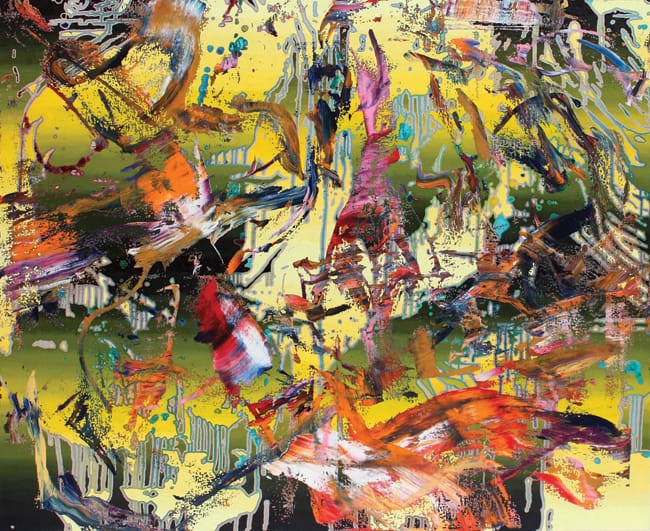
“Acapulco Gold,” 2016, Christopher Kuhn, oil and acrylic on linen, 55″ x 67 1⁄4″ x 1 1⁄2″
Photo: courtesy Bentley Gallery
The 27 artists represented in “Abstraction in the Singular” not only favor abstraction, they revel in its ability to convey whatever is on their minds. Each work communicates in a number of ways: gestural strokes, geometric precision, organic layering and atmospheric moods, to name a few. In addition, the show’s roster tilts toward Arizona and California abstract painters, bolstering the genre’s status in the West. According to guest curator Grant Vetter, the work of these artists stands opposed to “”Zombie Formalism”” —a term coined by Walter Robinson and further explained by Jerry Saltz: lookalike, unchallenging abstract paintings derivative of famous artists that nevertheless have soared in popularity.
Instead, the show offers plentiful evidence of how the genre allows artists to follow widely divergent—in essence, singular—paths. There’s the seduction of Jonathan Apgar’s Outside Context Problem (2015), which glistens with silvery-white cloudlike shapes on blue. Rema Ghuloum’s After Hours, After Night, After Light (2015) similarly conjures a dreamy blue atmosphere. However, it’s harder to find your way into Christopher Kuhn’s nearby work, mysteriously titled Acapulco Gold (2016). The artist tricks the eye with drips, crooked lines and swaths of yellows, oranges and greens, applied in such furiously dense layers that their order can’t be discerned. Meanwhile, several of the artists use abstraction to comment on the natural world. Mark Pomilio’s CB.5 (2015) is a profusion of polygons and triangles, some fading into the background, that call to mind nature’s infinite ability to reproduce itself. On top of that, it’s a shaped painting on linen that bends in two places to further suggest spatiality. Travis Rice also deals in repetitive triangular shapes in Dismantled (2016), using acrylic, vinyl and pumice, all precisely applied. The effect is one of exploding pixels or shattered glass. On the other hand, Michael Kindred Knight’s Winthrop (2017) is meditative in its seeming simplicity. Interwoven bands of blue, gray, purple and gold are skill fully given feathered, uneven ends, as if the artist is asking us to think about what constitutes a finished painting. Alison Rash’s Untitled Wave (2017) also merits concentrated study, for its interplay of irregular stripes in watery gradations of blue.
With such a viscerally compelling, heterogeneous selection of abstract paintings, it’s possible to gain newfound respect for this historically complex genre, and perhaps even to scare Zombie Formalism away.